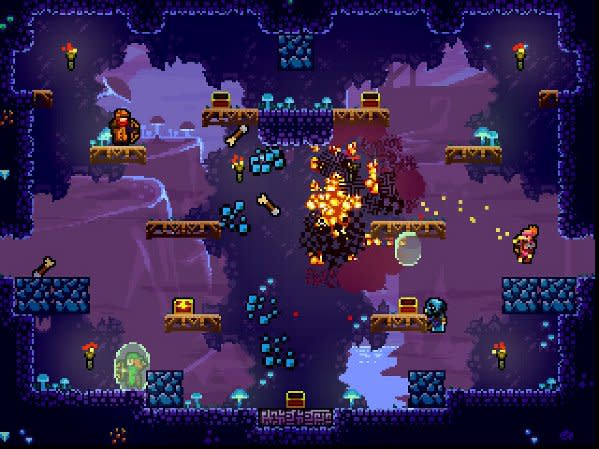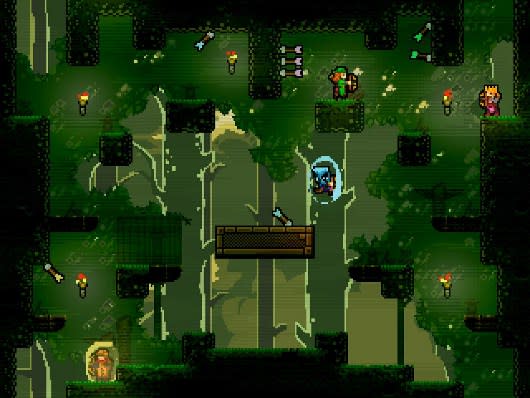TowerFall: Ascension review: Exploding corpses
TowerFall: Ascension is deceiving. It appears to be cute, pixelated and friendly, and it looks like something you would have played between rounds of Contra and Super Mario Bros on the NES as a kid.
In reality, TowerFall is a brutal bow-and-arrow brawler with vicious enemies that materialize from the ether in droves, heedless of whether you have backup or the skills to defeat them. You have a set number of lives, limited ammo, power-ups that disappear the moment you're hit, and hordes of enemies that demonstrate increasingly complex powers as the levels progress. It's also local co-op only.
So, yeah – it's basically the reincarnated amalgamation of classic NES shoot-em-ups and platformers, bred for a more technologically powerful world.
TowerFall's charm resides in its twists on beloved platformers and shooters: Jump down a hole at the bottom of the map and re-appear at the top, dropping from a gap in the ceiling. Shoot a barrage of arrows and then jump down and collect them from the bodies of the slain. Challenge friends and choose big head mode, play with laser arrows only, play in slow-motion, turn on constant side-scrolling or a myriad of other game tweaks. (Also included among those: exploding corpses.)
TowerFall rewards patience and calculated risk in both of its main modes, the multiplayer Versus mode and the solo or two-player Quest mode. The first level in Quest offers a fairly simple demonstration of what TowerFall has to offer, namely, piles of ghosts, slime balls, flying eyeballs and eventually, on stage five, another archer. It offers a balance, both challenging players and allowing them to grasp the simple controls – shoot, jump and dodge.
I'm convinced the first level exists not to train the player for what is to come, but to cultivate the perception that this cute, pixelated romp is easy fun. It does a wonderful job of lulling you into a false sense of security before the real game begins, and the real enemies appear. In large numbers. All levels after the first feature a variety of enemies, including assassins, death himself, birds, tornado-throwing hawk-men and other beasties with special abilities, all determined to kill your little archer. Suffice it to say that going into TowerFall alone is an arduous task.
Luckily, it's also a fun one. TowerFall mimics the frustration in games of yore, offering just enough hope that next time, you'll be able to beat all of those nasty beasties. Or maybe next time. Well, maybe the next time. The mechanics are butter, allowing for rapid transitions among platforms and across the screen, all while flinging arrows at enemies or bouncing on their heads. It's a game for a wide range of players, combining asset management and twitch controls with platforming and wonky physics. It's superbly satisfying to launch a shot into an enemy's back, jump to collect the arrow, leap down the gap at the bottom of the level and pop up at the top, directly on top of the boss enemy's head.
It's less satisfying when a rolling slimeball does the same to you, but it all shakes out in the end.
You have five lives at the start of each level, and when you die, your avatar respawns encased in a gem. To resume playing, you smash the jump button until the gem bursts open in a hail of fire and smoke that kills anything near it – it's cathartic button-mashing and a fancy weapon, all in one. You'll probably use it a lot more than you'd hope. And that's in Normal difficulty.
This is where TowerFall's true message shines through: Play with a friend. Quest mode is infinitely less stressful with a partner covering one half of the map, since each section is basically a complete level on its own. Quest allows for one or two players cooperatively, though there is friendly fire, so watch out (or find friends with better aim).
The "play with friends" message still holds strong in the competitive Versus mode. Two to four players – again, local only – choose their archers from four avatars that look different, but perform the same moves, and then pick from three modes: deathmatch, team deathmatch or last man standing. Each match is heavily customizable, which is where things get interesting.

There are dozens of options to configure, ranging from equipping everyone with bomb arrows to adding lava to the edges of the map, having players respawn as ghosts, making floors slippery, giving everyone wings, or eliminating certain arrow types and items.
One lineup of variants my friends found particularly grueling and hilarious was a mix of exploding corpses, trapped bomb chests and bramble arrows – a relatively simple set-up, given all of the choices, but effective nonetheless. Bramble arrows are a curiosity: When they hit an object, the arrow turns into a lethal patch of bushy spikes the color of the archer who shot it. One touch, even if it's your own bramble patch, and you're dead. By the end of the match, no one was killed by an actual arrow, but rather by an exploding dead body or one of the giant, terrifying plants growing all along the platforms, ceiling and walls.
The lack of online play is unfortunate, but the local restriction does come with benefits, namely that you're always in punching distance of the jerk who just killed you. Even so, some leaderboards would have been nice.
If TowerFall: Ascension had launched around the same time as Super Mario Bros, many of us may never have found the princess. It's not just the pixel-art graphics, but the entire feel of TowerFall that makes it addictive. In every moment, you must gauge how many arrows you have, where the last arrow landed, where enemies (or friends) will drop in and how many shots it will take to obliterate the nearest threat. It's a whole-brain game with minimal controls, and it's the most fun I've had with a bow and arrow since The Year Of The Bow – or even the 1980s.

This review is based on a Steam download of TowerFall: Ascension, provided by Matt Makes Games. TowerFall: Ascension is also available for PS4. Images: Matt Makes Games.
Joystiq's review scores are based on a scale of whether the game in question is worth your time -- a five-star being a definitive "yes," and a one-star being a definitive "no." Read here for more information on our ratings guidelines.


